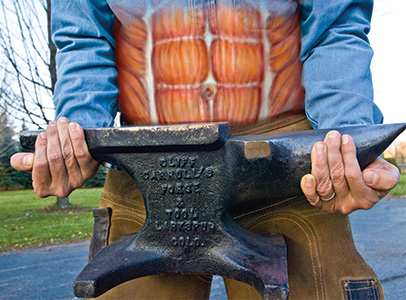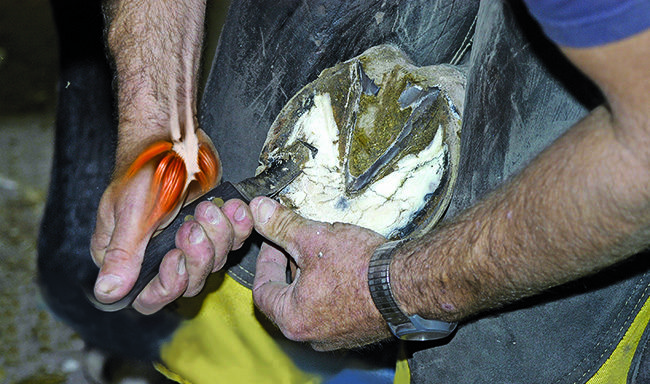Not visualized in the diagram, but located at the wrist, your median nerve supplies feeling and movement to areas of your hand.
Neurosurgeon James Warson, horseman and author of The Rider’s Pain-Free Back, says he’s always mindful of what he refers to as the three basic principles of life.
“Everything goes somewhere, everything is connected to something else and there’s no such thing as a free lunch,” he says, pointing out that even the smallest actions can have long-term consequences when it comes to physiology and well-being over the course of a long hoof-care career.
Warson has had significant experience with farriers and their work. He’s observed and collaborated with many shoers in his horse breeding operations, first growing up on his family’s working cattle ranch in Texas and later in his own Morgan and Saddlebred endeavors with J & J Farms, LLC, of Fairfax, Va., established in 1984. He’s also trimmed and shod a few horses in his day.
Common Problems
When it comes to the physical wear and tear he’s seen in horseshoers, Warson says the most common issues aren’t what you might imagine.
“You’d think the most common would be carpal tunnel syndrome with the amount of hammering, pulling and tugging,” he says. “It’s something I often find in carpenters, but maybe putting a nail into a horse’s hoof isn’t as wearing on the wrist’s median nerve as hammering into lumber day after day.”
“What I do see is a lot of osteoarthritis in the knees. Once they get that hoof in place, locking their knees and extending them a bit, that’s a lot of pressure on those joints. If you watch a really old farrier walk, you can tell they’ve gone a few extra miles.”
He adds that as a group, farriers also have some of the strongest backs of any you’ll find. “I’m amazed that every farrier isn’t crippled from the things they do. They’ll put that hoof in place, and there’s a strong pull on their back’s extension muscles,” says Warson.
“Many complain of back pain, and I’ve operated on some farriers, but generally they have pretty healthy backs when compared to the general population.”
Warson reports that when he watches farriers work, his frame of reference is to look at how their actions or the environment might hurt them. That could include improper body mechanics, ergonomic problems with equipment and tools or even occupational safety hazards such as lack of eye and ear protection around the forge and power tools.
He adds that those able to make it a long-term career were strong to begin with, and get stronger through their work. “I think the weak simply fade away.”
... And A Second Opinion
Another doctor (an orthopedic surgeon) that’s seen his fair share of horseshoeing patients is also a farrier: Dr. Michael Miller, FWCF, APF, CJF, of Huntsville, Ala.
“My background is really bizarre,” he says. “I finished Cal Poly (California Polytechnic State University) horseshoeing school in the late 1960s, then paid my way through medical school by shoeing. The Cal Poly school is no longer there, but it was one of the first really good horseshoeing schools.”
Miller adds that after 42 years of shoeing, his body reflects every horse he’s been under. “I’ve had to back off a little in recent years. I’m 67 and still shoeing, but my body’s showing it.”
As a long-time farrier, Miller can equate physical wear and tear to specific actions.
“In my practice, I see a lot of repetitive stress issues and carpal tunnel with farriers,” he says. “I also see a lot more elbow issues, like tennis elbow, from hammering. That’s because a lot of beginners will grip the hammer too hard, rather than having a loose grip and almost ‘throwing’ down the hammer so it does the work for you.”
Other problems he sees include wrist, elbow and shoulder-related joint issues. “Wrist problems can come from working with the farrier’s knife and forging. These types of things are all more common in farriers who cold-shoe, because there’s a lot more concussion taking a toll on your arms and wrists.”
How To Tell When Trouble’s A-Brewin’
Maybe you’re feeling fine now, or you just get a little stiffness first thing in the morning or after a long drive. But experts say those are the first hints from your body that the scales are tipping.

Lack of physical fitness and over-reliance and poor use of other areas of your body can lead to a weakened core and abdominal muscles.
“Our problem is as we age our backs age — just like every tissue in our bodies,” advises Warson, who says if you’re watchful, there are signs that degeneration is getting a toehold.
“You’ll start to notice stiffness, either in the mornings or when the weather is cool and damp. Or, you’ll notice pain upon standing, or when standing after sitting. If you have to unkink yourself, it shows your back is experiencing degenerative spinal disease or osteoarthritis,” he says.
Miller adds that it’s important not to ignore those nagging aches and pains. “If it’s a persistent problem, that’s a warning, as are radicular or radiating pains traveling from the buttocks down the back of the legs into the foot. Those are the two biggest things to watch out for.”
Similarly, any tension, stiffness or pain in the hands and arms can be precursors to more serious problems and should be addressed when they first crop up.
According to Warson, these signs can be a slippery slope to irreversible damage. “Once disc problems happen, such as a slipped or herniated disc, you can have surgery but the damage is already done. There are now artificial discs that are used in the neck, but they don’t really work in the lumbar (lower back) region or for anyone doing heavy work.”
Use It Or Lose It
Farriers often have full schedules and long days. Since horseshoeing is a physically taxing occupation that leaves you dog-tired at the end of the day, many farriers don’t make time for physical conditioning; Miller says that’s a mistake.
“Most farriers get home and want to put their feet up and have a few beers. They figure because of the work they do they’re stronger than if they had an office job, and that’s true, but doing some strength and flexibility training will go a long way to balance and counteract the physical stresses and wear and tear of the job,” says Miller, who reports he’s started doing the P90X fitness training regimen and credits it with his ability to continue shoeing.
“I know about 20 farriers using the P90X program and it’s helped all of them with strength and flexibility, plus they’ve lost a significant amount of weight. But it won’t work for you if you’re not a morning person, because it’s too hard to come home and do that program after doing farrier work all day.”
Miller says that to the trained eye, the body will clearly show where the deficiencies and problems are.
“You’ll see a lot of strong farriers who have a big potbelly,” he says. “It’s because their core and abdominal muscles are really slack from lack of use. Or you’ll see a guy with no butt — that usually means his lumbar strength is gone from keeping his legs straight and bending over at the waist. He’s either got or will develop back pain because of it.”
Farrier work is active work, but when it comes to movement there’s a difference between degenerative or deteriorating activities and what’s considered generative or therapeutic.
To emphasize building flexibility, core strength and long, lean muscles, try a movement-based exercise program like Pilates, a physical fitness system developed by Joseph Pilates in the early 1900s. Or, a movement education system such as the Alexander Technique can shine a light on inefficient or counterproductive movement patterns, helping you to correct bad habits before serious problems crop up.
Warm Hands, Warm Heart
Flexibility and range of motion are important parts of the farrier fitness equation. “To shoe a shorter horse or pony you really use your back, and a lack of leg and lumbar strength combined with a lack of flexibility leads to a breakdown there,” says Miller, who has had two back surgeries due to his shoeing career. So what’s the best way to not only keep what you have but enhance it?

If you frequently experience tennis elbow, the issue may be caused by a poor grip and misuse of the hammer at the anvil.
A pre-work warm-up (like a light jog, even if it’s in place) or a few gentle movements before getting started can warm your temperature, increase blood flow and prepare your body to better handle the physical exertion. However, according to a 2010 article from The Journal News Media Group (a Gannett, Inc. company at www.LoHud.com), when it comes to stretching, the type and timing are important.
The article, titled “Experts: Forget Pre-Workout Stretching, It Might Make You Slow” points out that ‘static stretching’ or doing things like toe touches can actually make your muscles contract rather than relax because your body is tensing as protection against over-stretching. This is the opposite of what you want to happen.
Common wisdom also says stretching before exercise is an effective warm-up and injury prevention, but research by the U.S. Centers for Disease Control and Prevention (CDC) points out that “active stretches” (ones that mimic the activity movement, but with less intensity) or activities such as yoga are actually as beneficial as flexibility training.
At the very least, it’s advisable to do some post-work stretches, such as after each horse, before you climb back into your rig for a drive to the next client and/or at the end of the day’s work, as a way to elongate your already-warm muscles and maintain your overall range of motion.
Resources For A Safer Work Experience
Even if these are topics you haven’t considered before, there’s a wealth of information as close as the nearest computer. Begin your search with terms like “occupational safety, workplace hazards and farrier ergonomics,” or look up these resources online:
- To learn how to counteract the vision and hearing occupational hazards that horseshoers face daily, check out the 2011 Getting Started In Hoof Care article by AFJ Managing Editor Pat Tearney titled “On-The-Job Safety.”
- Check out “Dealing With Chronic Elbow Pain” to learn more about minimizing and managing this type of issue. This article by Dr. John Palmer ran in the December 2000 issue.
- Michelle Altemus wrote “Shoeing’s A Real Pain” in the December 2001 issue to explain how to prevent back discomfort.
- Educational resources on workplace safety are available at the United States Department of Labor website (www.osha.gov) for the Occupational Safety & Health Administration (OSHA), including publications that have guidelines to recognize and control ergonomics-related risk factors.
- The European Agency for Safety and Health at Work (EU-OSHA) governs workplaces in the European Union (EU), and has similar information available at www.osha.europa.eu.








Post a comment
Report Abusive Comment